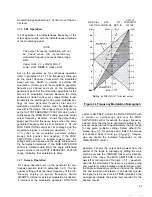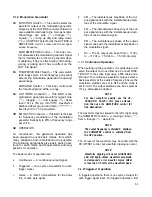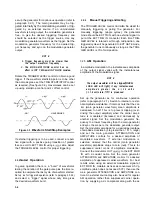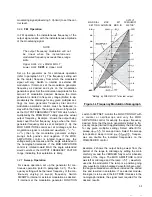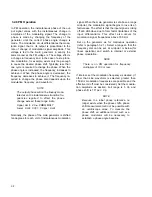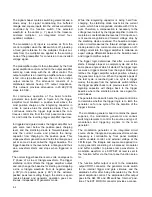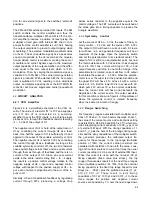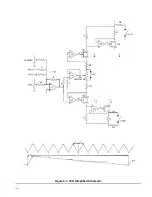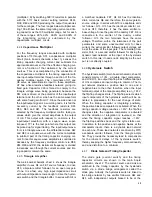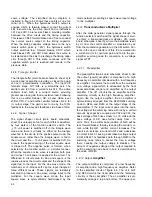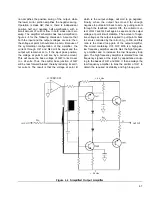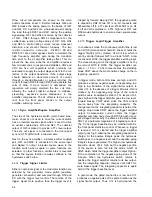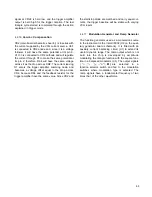
3.1.2 Modulation Generator
14
15
16
17
32
.
For
FUNCTION Switch - This switch selects the
waveform output of the modulation generator.
Output is at the OUT BNC connector
16
and is
also available internally to the main generator.
Waveforms are sine
(
),
triangle
(
),
square
(
),
ramp up (M) and ramp down
A SWP SET detent holds the OUT BNC at
AMPLITUDE
control 14 level;
used
to set upper
sweep frequency.
MOD AMPLITUDE Control - This inner con-
trol attenuates the modulation generator signal
that is internally fed to the main generator when
modulating. It has no effect during internal trig-
gering or gating and it has no effect on the
OUT
16
signal.
FREQ/PERIOD MULT Switch - This outer switch
(with ranges given in both frequency and period)
selects the modulation generator frequency/
period range.
VARIABLE Control - This inner control sets
the frequency/period within a range.
OUT
Connector - This BNC is the
modulation generator waveform output: sine
(
),
triangle
(
)
and square
(
)
fixed
level 1OV p-p (5V p-p into
waveforms
balanced about ground and ramp
(
)
fixed level 0 to + 5 Vp waveform.
FM IN (5
Connector - This BNC is the input
for frequency modulation of the modulation
generator. Sensitivity is 20% of frequency range
per volt in.
OPERATlON
convenience,
the generator operation has
been grouped in seven basic modes, from which
many variations and combinations are possible.
The following paragraphs give basic switch posi-
tions for each mode and requirements and sug-
gestions for operation.
The basic modes of operation are:
a.
Continuous - A continuous output signal.
b
.
Triggered - One cycle of waveform for each
trigger signal.
C.
Gated - A “burst” of waveforms for the dura-
tion of each gate signal.
d .
AM - The instantaneous amplitude of the out-
put signal varies with the instantaneous ampli-
tude of the modulation signal.
e.
FM - The instantaneous frequency of the out-
put signal varies with the instantaneous ampli-
tude of the modulation signal.
f
.
PM - The instantaneous phase of the output
signal varies with the instantaneous amplitude of
the modulation signal.
g .
DC - The dc output can be set from + 15 Vdc
to - 15 Vdc
(+
7.5 Vdc to - 7.5 Vdc into
3.2.1
Continuous Operation
When setting up the generator, it is advisable to ob-
serve the output on an oscilloscope. Connect FUNC-
TION OUT to the scope input using a 500 cable and a
load. For continuous waveform output, select a
basic waveform at the desired frequency. Ensure the
modulation switches are set to OFF and the mode is
set to
The output amplitude can be as great as
15V p.p; attenuate as desired.
NOTE
For best waveform quality, use the AT-
TENUATIO N
SWITC H
for gross attenua-
tion; then use the AMPLITUDE control for
fine attenuation.
The waveform may be skewed to the left or right using
the SYMMETRY control; e.g., making a ramp
(
)
from a triangle
(
.)
waveform.
NOTE
The output frequency is divided b
y
10 when
the SYMMETRY control is switched from
the OFF position.
The dc level of the waveform may be varied with the
DC OFFSET control, but waveform clipping can occur.
NOTE
Waveform clipping will occur (OVERLOAD
LED will light), unless waveform amplitude
is decreased so
that
wavefor m plus offset
is less than 7.5 volts at the waveform peak.
3.2. 2
Triggered Operation
In triggered operation, there is one cycle of output for
each trigger signal input. For triggered operation, first
3-3








